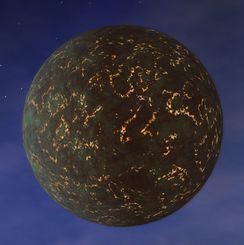
|
This wiki is closed in favour of the new wiki. Information shown is likely to be very out of date. |
Difference between revisions of "Socorro"
From Discovery Wiki
Jump to navigationJump to search (replaced: {{Version|4.85.3}} → {{Version|4.85.2}}) |
m (category added) |
||
| (2 intermediate revisions by 2 users not shown) | |||
| Line 1: | Line 1: | ||
| − | {{Version|4. | + | {{Version|4.91}} |
{{Planet Infobox | {{Planet Infobox | ||
| name = Socorro | | name = Socorro | ||
| − | | image = Socorro. | + | | image = Socorro.jpg |
| owner = | | owner = | ||
| system = [[Coronado]] | | system = [[Coronado]] | ||
| Line 15: | Line 15: | ||
| escape_velocity = 15.42 km/sec | | escape_velocity = 15.42 km/sec | ||
}} | }} | ||
| − | Socorro is a | + | Socorro is a moon of the [[Planet Salina]], mainly composed of Iron with deposits of [[Nickel]] and an atmosphere of carbon-dioxide and argon. Being tidally locked to Salina, the two hemispheres of the moon experience very different day night cylces. The Salina side of the moon has a day of dim twilight when passing the sun facing side of Salina, a pair of periods of both Salina light and Sunlight in its morning and evening, and a noon of darkness while it basks in the infrared glow of Gas Giant Salina, while the other side experiences a fairly standard day/night cycle of only four and a half standard days each day and each night. |
| + | |||
| + | |||
| + | [[Category: Independent Systems]] | ||
| + | [[Category: Coronado]] | ||
Latest revision as of 09:32, 24 February 2019
| Socorro | |
| Location | 5F, Coronado Independent Systems |
| Technical information | |
| Docking | No |
| Terrain | N/A |
| Diameter | 3,837 km |
| Mass | 3.23 x 10e24 kg |
| Temperature | N/A |
| Escape velocity | 15.42 km/sec |
Socorro is a moon of the Planet Salina, mainly composed of Iron with deposits of Nickel and an atmosphere of carbon-dioxide and argon. Being tidally locked to Salina, the two hemispheres of the moon experience very different day night cylces. The Salina side of the moon has a day of dim twilight when passing the sun facing side of Salina, a pair of periods of both Salina light and Sunlight in its morning and evening, and a noon of darkness while it basks in the infrared glow of Gas Giant Salina, while the other side experiences a fairly standard day/night cycle of only four and a half standard days each day and each night.
